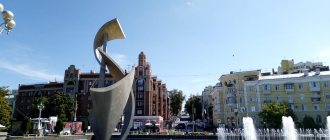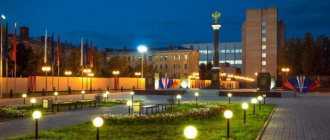origin of name
The city of Shakhunya received its name from a nearby village, which, in turn, was named after a river that flowed nearby. The name of the river comes from the Old Russian “shaha” - deception (Shakhunya - “deceiver”). The reason for this name is the variability of the riverbed: the peat banks of Shakhunya were easily washed away by water in rain or flood, which made the construction of a permanent bridge impossible. In addition, local historian V.V. Smirnov voiced another version: the river in the old days was narrow, and it was easy to step over (“step over”) anywhere; this same version is mentioned in the Nizhny Novgorod toponymic dictionary as a legend.
Virtual pilgrimage. (We visit churches in cities and villages)…
.Shahunya. Church of the Intercession of the Blessed Virgin Mary. m.ok.ru/pokrovaboz Thrones: Intercession of the Blessed Virgin Mary Year of construction: 1994. Address: Russia, Nizhny Novgorod region, Shakhunsky district, Shakhunya. In the city of Shakhunya there is only an Orthodox church in honor of the Intercession of the Mother of God, located on the territory of the city Park of Culture. Shakhunya is a young town, there are no ancient temples here, but there is a recently built Intercession Church and several chapels. For a long time, the city did not have its own temple, and the Orthodox community of Shakhunya, formed in the 80s, held religious ceremonies and prayers in the prayer house. In the 90s, it was decided to build a church in the city. This is a brick building, built in the traditional style: a rectangular quadrangle of two floors, topped with a five-domed building. Nearby is a bell tower, built in the same style. The whiteness of the walls of the Church of the Intercession is set off by the soft blue covering of the roof, both on the church building itself and on the hipped roof of the bell tower. There is also a Sunday school next to it. Shakhunya is a city since 1943 in the Nizhny Novgorod region, Russia. Founded in 1921 as a settlement for construction workers of the Nizhny Novgorod - Kotelnich railway. The city is located northeast of Nizhny Novgorod, 264 kilometers along the highway and 240 kilometers along the Nizhny Novgorod-Kirov railway. The city of Shakhunya received its name from a nearby village, which, in turn, was named after a river that flowed nearby. The name of the river comes from the ancient Russian “shaha” - deception, Shakhunya - “deceiver”. The reason for this name is the variability of the riverbed: the peat banks of Shakhunya were easily washed away by water in rain or flood, which made the construction of a permanent bridge impossible. Small-scale resettlement to this area began in the thirties of the 19th century with the transfer of state peasants from a number of places in the Kostroma province. In 1870, the village of Shakhunya had seventeen inhabitants. In 1921, a station village was founded, where the builders of the Nizhny Novgorod - Kotelnich railway settled. During the period from 1923 to 1927, a railway depot, a station and a power station were built. On October 21, 1943, the village was given city status. In the 1970s, Shakhunya became a city of new buildings. In 1972, on the outskirts of Shakhunya, a plant for the production of skimmed milk powder with a butter-making workshop and whole milk products was founded. During the Soviet years, the products of this plant entered the world market and were sold in the Netherlands, Poland and Afghanistan. Five-story residential buildings - Khrushchev-era buildings - are being built near the railway station, the outskirts are being settled, and the appearance of the city is being transformed by wide green streets.
Economy
The largest and city-forming enterprise of the city is OJSC “Moloko”; the company’s share in the total volume of shipped products is 44.3%. The enterprise has been operating since 1971, and since 2003 it has been an agricultural holding with eleven agricultural enterprises for receiving and processing milk; and two trading houses. Produces the Severnaya Dolina brand.
The railway, which stood at the origins of the city's history, is represented by three enterprises: a carriage depot, a locomotive depot, a container repair depot and the railway station itself. As of 2014, the wagon depot produces wheelsets and containers for wagons and repairs freight wagons.
To process forest resources, wood processing enterprises have been put into production: Agat OJSC, Shakhunsky Industrial Plant, Rubikon LLC, Profile LLC.
The area has plenty of farms, including an ostrich farm (Arfa OJSC) and a poultry farm. The first is engaged in breeding ostriches and selling eggs, while the second produces chicken eggs and meat. The city produces meat products. The Apis LLC meat processing plant produces meat from poultry, cattle, pigs, sheep, goats and horses. An ostrich farm and poultry factory produce meat and eggs.
Weaving factory (LLC "Woven Patterns").
History[edit]
The rapid development of the village and this entire area began after the October Revolution in connection with the construction of the railway. In 1933, Shakhunya became a workers' village, and in 1943 the workers' village was already transformed into a city.
The name is given by the name of the Shikhunya river. That was the name of the first repair.
The city began its life on the site of a dense forest, but quickly overtook Vetluga in population and took on the role of the organizational center of the north-east of the Gorky region, the so-called Zavetluga region, standing out not only as an administrative center and a major junction on the Gorky railway, but also as organizing interdistrict center. This was facilitated by the position of Shakhunya halfway between two regional centers - Gorky and Kirov.
They grew up together - the station and the city of Shakhunya. And this left an imprint on the history of the development of the distant forest region, on the fate of the people who transformed it. Basically, the residents of Shakhunya are highly professional railway workers, specialists in the forestry and wood chemical complex, as well as their children and grandchildren. Here live people in love with their land, who have preserved and cherish the traditions of the first settlers of the Shakhun land; they are persistent, purposeful, cheerful and, most importantly, believe in their land, in its bright future.
The emergence and development of Shakhunya is associated with the construction of the Nizhny Novgorod - Kotelnich railway, which began before the October Revolution of 1917. On one of the sections of the route, the railway line passed near the village of Shakhunya, three kilometers from which, according to the project, a station was installed, named after the name of the village. Thus, even before the birth of the city, its name arose. The location of the station was determined between two small rivers Chernaya and Samarikha. The railway crossed both rivers perpendicularly. The terrain was flat, low, and swampy in some places.
Of great importance for the development of the village of Shakhunya was the construction of a locomotive depot, which lasted about four years and was completed in 1927. This was the first large enterprise of Shakhunya, which required a lot of workers: mechanics, turners, blacksmiths, who significantly increased the population of the village. At the same time as the locomotive depot in Shakhunya, a power plant was built: Ilyich’s light bulbs lit up in the apartments of the railway workers.
In the 30s, many more railway enterprises and organizations were created in Shakhunya. Shakhunya is turning into a large railway junction on the Gorky Railway. The village of railway workers is also growing rapidly. During the war years, the importance of Shakhunya on the Gorky Railway increases and on October 21, 1943, the village was given the status of a city.
In memory of those generations of railway workers who worked selflessly from the very beginning of the depot’s foundation, a steam locomotive of the “LV” series, the latest technical word in Russian locomotive engineering, was installed for eternal parking on the station square of the Shakhunya station. It reminds us of the first generations of railway workers.
In the first post-war five-year plans, the young city quickly turned into a large industrial and commercial center in the north of the region. The industry of the Shakhun region is accelerating its growth rate. New industrial enterprises are being built in Shakhunya and the region, along with them the previously created ones continue to grow.
The seventies are especially famous for Shakhunya. It has become a city of new buildings. In 1972, on the outskirts of Shakhunya, a plant for the production of skim milk powder with a butter-making workshop and whole milk products, which are in demand not only in the Gorky region, but also beyond its borders, was built. The plant's products have entered the world market and are sold abroad to Holland, Poland, and Afghanistan. During these years, the appearance of Shakhunya changes greatly. Five-story residential buildings are being built in the center, and the outskirts of the city are being developed. The city has cozy neighborhoods, wide green streets, and the Shakhun residents themselves monitor their cleanliness and order and are engaged in the further improvement of their hometown.
Architecture and landmarks
In the city center there is a cultural and shopping ensemble. In the center of the city, in 1968, Sovetskaya Square was built, adjacent to it is the former building of the House of Soviets, now the local administration building. Adjacent to the side of the square is the “My Family” shopping center, a former dismantled wide-screen cinema “October” made of glass and concrete. Opposite it is the House of Communications. Opposite the administration building there is a grocery store and a library.
The general plan of the city of Shakhunyi was approved in 1966 by the executive committee of the Gorky Regional Council of Workers' Deputies, and Lengiprogor developed a detailed plan for the city center.
Monuments
Monument to fellow countrymen who fell in the Great Patriotic War. It appears to be a statue of three soldiers, one of them depicted in a fall, on a podium 2.5 meters high. In the summer of 2013, the ensemble of the monument was updated. Memorial plaques with lists of WWII participants who left Shakhunya have been replaced.
The monument to Dmitry Evlampievich Komarov is a stele on top with a bust of D. E. Komarov. Initially installed opposite the club named after M. S. Plaksin, but later [specify] moved to school No. 1.
In memory of those generations of railway workers who worked selflessly since the foundation of the depot, a steam locomotive of the “L” series with number 2162, one of the best and most popular Soviet steam locomotives, was installed for eternal parking on the station square of the Shakhunya station. It reminds us of the first generations of railway workers.
In 2011, memorial plaques dedicated to the participants of the Afghan war who studied at the school were installed in the gymnasium and secondary school No. 1. Sergei Nikolaevich Mironov, who died in Afghanistan. Awarded the Order of the Red Star.
Map
| Shakhunya: maps |
Shakhunya: photo from space (Google Maps) Shakhunya: photo from space (Microsoft Virtual Earth)
| Shakhunya. Nearest cities. Distances in km. on the map (in brackets along roads) + direction. Using the hyperlink in the distance , you can get the route (information courtesy of the AutoTransInfo website) | |||
| 1 | Tonshaevo | 24 (28) | IN |
| 2 | Tonkino | 33 (44) | YU |
| 3 | Kiknur (Kirov region) | 53 (57) | SE |
| 4 | Vetluga | 53 (61) | NW |
| 5 | Uren | 54 (53) | SW |
| 6 | Sharanga | 55 (70) | YU |
| 7 | Leninskoe (Kirov region) | 76 (229) | WITH |
| 8 | Ponazirevo (Kostroma region) | 78 (177) | WITH |
| 9 | Tuzha (Kirov region) | 79 (136) | IN |
| 10 | Candle (Kirov region) | 84 (251) | NE |
| 11 | Yaransk | 85 (99) | SE |
| 12 | Sanchursk (Kirov region) | 89 (157) | SE |
| 13 | Varnavino | 96 (148) | Z |
| 14 | Kilemary (Republic of Mari El) | 98 (242) | YU |
| 15 | Arbazh (Kirov region) | 100 (160) | IN |
| 16 | Sharya | 101 (129) | NW |
| 17 | Vetluzhsky (Kostroma region) | 104 (131) | NW |
| 18 | Red Buckies | 105 (111) | SW |
| 19 | Vetluzhsky | 105 (117) | SW |
| 20 | Orshanka (Republic of Mari El) | 113 (150) | SE |
| 21 | Pizhanka (Kirov region) | 116 (143) | IN |
| 22 | Voskresenskoye | 116 (153) | SW |
a brief description of
The city is located in Zavetluzhye, 240 km northeast of Nizhny Novgorod. Railway station. Road junction.
Territory (sq. km): 2588
Information about the city of Shakhunya on the Russian Wikipedia website
Historical sketch
Founded in 1921 as a village near the railway. Shakhunya station (opened in 1927) during the construction of the Nizhny Novgorod - Kotelnich railway, 3 km from the village of Shakhunya. The name of the village is associated with the surname of the first settler Shakhunsky.
In 1920, several barracks were built, in 1927 a station and a locomotive depot were built, in the 1930s. - power station. Since 1933 a workers' settlement, since 1943 the city of Shakhunya.
Economy
Wood processing and food industry enterprises. Art factory (produces sewing, woven products, etc.).
In the Shakhunsky district, grains, potatoes, and fiber flax are grown. They raise cattle, pigs, and sheep.
Culture, science, education
Obelisk in honor of fellow countrymen who died in the Great Patriotic War of 1941-45.
Architecture, sights
The city is built up with 2-5-story standard residential buildings.
| Population by year (thousands of inhabitants) | |||||||
| 1926 | 10.2 | 1992 | 22.7 | 2007 | 21.4 | 2015 | 20.4 |
| 1939 | 10.2 | 1996 | 23.4 | 2008 | 21.4 | 2016 | 20.2 |
| 1959 | 21.3 | 2000 | 23.6 | 2010 | 21.3 | 2017 | 20.2 |
| 1967 | 20 | 2001 | 23.5 | 2011 | 20.9 | 2018 | 20.0 |
| 1970 | 20.1 | 2003 | 21.7 | 2012 | 20.8 | 2019 | 19.8 |
| 1979 | 21.0 | 2005 | 21.6 | 2013 | 20.7 | 2020 | 19.7 |
| 1989 | 22.3 | 2006 | 21.4 | 2014 | 20.5 | 2021 | 19.6 |
Education and science
There are 7 municipal kindergartens in the city
- Municipal educational institution Shakhunskaya secondary school No. 1 named after. D. E. Komarova with a teaching staff of 40 people. In 2012, the school turned 75 years old, and the first graduate was in 1940. During its existence, the school has had 8 directors. In accordance with the License, the school implements educational programs at three levels of education.
- MBOU "Shakhun Gymnasium named after. A. S. Pushkin" with a teaching staff of 38 people[69]. Created in 1994. An institution of higher status implements programs of primary general, basic general and secondary (complete) education, as well as additional education and programs for in-depth study of the Russian language, literature and English.
- Municipal educational institution Shakhunskaya secondary school No. 14 was founded in 1919. Since 2000, a science and mathematics class has been opened. Municipal educational institution Secondary School No. 14 is rightfully considered the largest school in the area. Currently there are more than 700 students. About 60 first-graders come to school every year. Graduates of the school enter leading universities in Russia. Municipal educational institution Shakhunskaya secondary school No. 2 has been operating since 1962.
- GBOU SPO "Shakhun Agro-Industrial College" was founded in 1941 as the Railway School. It has three branches in Tonkino, Uren and Sharanga. At the economic base there is a branch of the Nizhny Novgorod University named after. Lobachevsky.
Transport
The city's transport system is represented by the following modes of transport: railway, road, taxi. There are developed suburban and intercity bus and train services. There is a railway station in Shakhunya. In close proximity to the city there is a regional highway P159 connecting Nizhny Novgorod and Yaransk. The Nizhny Novgorod - Kotelnich railway route is through and passenger branded trains currently run along it.
Street and road network
The city of Shakhunya has a rectangular road network. The advantage of this scheme is the absence of a clearly defined central transport hub, a relatively uniform traffic load on all streets and the high throughput of the entire system as a whole, due to the presence of redundant connections. The disadvantage of the scheme is the lack of the shortest connections in the most active diagonal directions, but this disadvantage does not have a significant impact on the functioning of the urban transport system as a whole.
The city's public transport is represented by bus and taxi. The urban transport network has a developed part that connects all parts of the city with each other: from the village of Yanvari to the village of Krasny Kirpichnik. From the Yaranskoe highway to the Leskhoz microdistrict.
Suburban and intercity buses
Suburban and intercity buses leave from the bus station, which is located next to the train station. There is a developed route connection with all cities and towns of the urban district of the city of Shakhunya, as well as intercity flights to the cities of Yaransk and Vakhtan. Buses do not go to large cities (Kirov, Nizhny Novgorod, Yoshkar-Ola). These routes run along suburban railway lines.
Buses for the city are provided by the Passenger Motor Transport Enterprise (PAP).
Shakhunya
(Nizhny Novgorod Region)
OKATO code:
22458
Founded:
1921
Urban-type settlement since:
1933
City since:
1943 City of regional subordination
Center:
Shakhunsky district
Urban-type settlements, population as of 01/1/2021
| Vakhtan | 4.6 | Syava | 3.5 |
| Telephone code (reference phone) | |
| 83152***** | 22-1-21 |
Deviation from Moscow time, hours:
0
Geographic latitude:
57°40′
Geographic longitude:
46°37′
Altitude above sea level, meters:
150 Sunrise and sunset times in the city of Shakhunya









